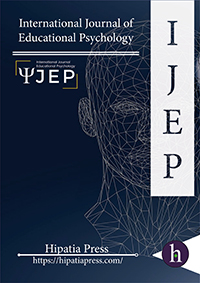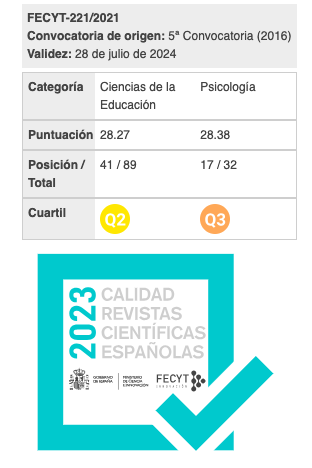The potential role of perceived support for reduction of special education teachers’ burnout
Keywords:
Downloads
Abstract
Teacher burnout is conceived as a general concern in special education because of the emotionally demanding work context. This study explored the potential role of perceived support for reduction of burnout in a sample of 276 special education teachers working in lower (n=130) and higher (n=146) secondary schools. Participants completed the Maslach Burnout Inventory - Educators Survey (MBI-ES) and a scale on the perceived collaboration and support from general education teachers. To explore the association between perceived support and each burnout measure considered (emotional exhaustion, depersonalisation, and personal accomplishment), correlation analyses were performed. Then, in order to check the robustness of our empirical findings, multilevel regression models (at teacher-school-administrative area level) were used controlling for several variables (teacher socio-demographic characteristics, teacher training and professional background, inclusive teaching practice and school context). Results suggest the potential role of perceived support in reducing emotional exhaustion and improving personal accomplishment in all the models considered. Instead, the relationship between perceived support and depersonalisation seems to be quite controversial, moreover when adding controls related to teacher’s training and professional background.Downloads
References
Acanfora, L. (2002). Come logora insegnare: Il burn out degli insegnanti [How stressful teaching is: Teacher burnout]. Roma: Edizioni Magi.
Google Scholar CrossrefAl-Shammari, Z. (2006). Special education teachers' attitudes toward autistic students in the autism school in the state of Kuwait: a case study. Journal of Instructional Psychology, 33(3), 170–178.
Google Scholar CrossrefAnderson, M. B. G., & Iwanicki, E. F. (1984). Teacher motivation and its relationship to burnout. Educational Administration Quarterly, 20(2), 109-132. doi: 10.1177/0013161X84020002007
Google Scholar CrossrefAvramidis, E., & Norwich, B. (2002). Teachers' attitudes towards integration/inclusion: A review of the literature. European Journal of Special Needs Education, 17, 129-147. doi: 10.1080/08856250210129056
Google Scholar CrossrefBataineh, O., & Alsagheer, A. (2012). An Investigation of Social Support and Burnout Among Special Education Teachers in the United Arab Emirates. International Journal of Special Education, 27(2), 5-13. Retrieved from http://www.internationaljournalofspecialeducation.com/articles.cfm?y=2012&v=27&n=2
Google Scholar CrossrefBillingsley, B., Carlson, E., & Klein, S. (2002). Working conditions and induction support of early career special educators. Exceptional Children, 70, 333-347.
Google Scholar CrossrefBronfenbrenner, U. (1977). Toward an experimental ecology of human development. American Psychologist, 32, 513–531.
Google Scholar CrossrefBrownell, M. T., & Smith, S. W. (1993). Understanding special education teacher attrition: A conceptual model and implications for teacher educators. Teacher Education and Special Education, 16, 270–282. doi:10.1177/088840649301600309
Google Scholar CrossrefBrownell, M.T., Smith, S.W., McNellis, J.R., & Miller, D. (1997). Attrition in special education: Why teachers leave the classroom and where they go. Exceptionality, 7(3), 143-155. doi: 10.1207/s15327035ex0703_4
Google Scholar CrossrefBrunsting, N. C., Sreckovic, M. A., & Lane, K. L. (2014). Special education teacher burnout: A synthesis of research from 1979 to 2013. Education and Treatment. 37(4), 681-712. doi: 10.1353/etc.2014.0032
Google Scholar CrossrefBurke, R. J., & Greenglass, E. R. (1989). Psychological burnout among men and women in teaching: An examination of the Cherniss model. Human Relations, 42(3), 261-273. doi: 10.1177/001872678904200304
Google Scholar CrossrefByrne. B. M. (1991). Burnout: investigating the impact of background variables for elementary, intermediate, secondary, and university educators. Teaching and teacher education: An International Journal of Research, 7(2), 197–209. doi: 10.1016/0742-051X(91)90027-M
Google Scholar CrossrefByrne, B. M. (1999). The nomological network of teacher burnout: A literature review and empirically validated model. In R. Vandenberghe & A. M. Huberty (Eds.), Understanding and Preventing Teacher Burnout (pp. 15-37). England: Cambridge University Press.
Google Scholar CrossrefCancio, E. J., Albrecht, S. F., & Johns, B. H. (2013). Defining administrative support and its relationship to the attrition of teachers of students with emotional and behavioral disorders. Education and Treatment of Children, 36(4), 71-94. doi: 10.1353/etc.2013.0035
Google Scholar CrossrefCaputo, A., & Langher, V. (2014). Validation of the Collaboration and Support for Inclusive Teaching (CSIT) scale in special education teachers. Journal of Psychoeducational Assessment, 33(3) 210–222. doi: 10.1177/0734282914548335
Google Scholar CrossrefCarli., R., & Paniccia, R. M. (2003). Analisi della domanda: Teoria e tecnica dell intervento in psicologia clinica [Analysis of demand. Theory and technique of the intervention in clinical psychology]. Bologna: Il Mulino.
Google Scholar CrossrefCrane, S. J., & Iwanicki, E. F. (1986). Perceived Role Conflict, Role Ambiguity, and Burnout Among Special Education Teachers. Remedial and Special Education, 7(2), 24–31. doi: 10.1177/074193258600700206
Google Scholar CrossrefDillon, S. (2007, August 27). With turnover high, schools fight for teachers. The New York Times. Retrieved from http://nytimes. com
Google Scholar CrossrefEvers, W. J. G., Brouwers, A., & Tomic, W. (2002). Burnout and self-efficacy: A study on teachers’ beliefs when implementing an innovative educational system in the Netherlands. British Journal of Educational Psychology, 72(2), 227-243. doi: 10.1348/000709902158865
Google Scholar CrossrefFernet, C., Guay, F., Senécal, C. & Austin, S. (2012). Predicting intraindividual changes in teacher burnout: The role of perceived school environment and motivational factors. Teaching and Teacher Education, 28(4), 514-525. doi: 10.1016/j.tate.2011.11.013
Google Scholar CrossrefFernet, C., Senécal, C., Guay, F., Marsh, H., & Dowson, M. (2008). The Work Tasks Motivation Scale for Teachers (WTMST). Journal of Career Assessment, 16(2), 256-279. doi: 10.1177/1069072707305764
Google Scholar CrossrefFriedman, I. (2000). Burnout: shattered dreams of impeccable professional performance. Journal of Clinical Psychology, 56, 595-606. doi: 10.1002/(SICI)1097-4679(200005)56:5<595::AID-JCLP2>3.0.CO;2-Q
Google Scholar CrossrefFuternick, K. (2007). A possible dream: Retaining California teachers so all students learn. Sacramento: The Center for Teacher Quality, California State University.
Google Scholar CrossrefGersten, R., Keating, T., Yovanoff, P., & Harniss, M. K. (2001). Working in special education: Factors that enhance special educators' intent to stay. Exceptional Children, 67(4), 549-567.
Google Scholar CrossrefGreenglass , E. R., & Burke , R. J. (1988). Work and family precursors of burnout in teachers: Sex differences. Sex Roles, 18, 215-229. doi: 10.1007/BF00287791
Google Scholar CrossrefHaddad, A. (1998). Sources of social support among school counselors in Jordan and its relationship to burnout. International Journal for the Advancement of Counseling, 20,113-121. doi: 10.1023/A:1005324405249
Google Scholar CrossrefHakanen, J. J., Bakker, A. B., & Schaufeli,W. B. (2006). Burnout and work engagement among teachers. Journal of School Psychology, 43, 495-513. doi: 10.1016/j.jsp.2005.11.001
Google Scholar CrossrefHall, B. W, Villeme, M. G., & Phillippy, S. W (1988). Predisposition for burnout among first-year teachers. Teacher Educator, 24(2), 13-21. doi: 10.1080/08878738809554934
Google Scholar CrossrefHonawar, V. (2006). Alternative routes for special education teachers relieving shortages worsened by NCLB. Education Week, 25(34), 1-16.
Google Scholar CrossrefHox, J. (2002). Multilevel analysis. Techniques and applications. Mahwah, NJ: Lawrence Erlbaum.
Google Scholar CrossrefISTAT (2014). L’integrazione degli alunni con disabilità nelle scuole primarie e secondarie di primo grado statali e non statali [Inclusion of students with disabilities in primary and lower secodary public and nonpublic schools]. Retrieved from http://www.istat.it
Google Scholar CrossrefJennett, H. K., Harris, S. L., & Mesibov, G. B. (2003). Commitment to philosophy, teacher efficacy, and burnout among teachers of children with autism. Journal of Autism and Developmental Disorders, 33, 583-593. doi: 10.1023/B:JADD.0000005996.19417.57
Google Scholar CrossrefKaff, M. S. (2004). Multitasking is multiaxing: Why special educators are leaving the field. Preventing School Failure, 48(2), 10-17.
Google Scholar CrossrefKwakman, K. (2001). Work stress and workbased learning in secondary education: testing the Karasek model. Human Resource Development International, 4(4), 487-501.
Google Scholar CrossrefLau, P. S., Yuen, M. T., & Chan, R. M. (2005). Do demographic characteristics make a difference among Hong Kong secondary school teachers? Social Indicators Research, 71(1-3), 491-516. doi: 10.1007/s11205-004-8033-z
Google Scholar CrossrefLeung, D. Y. P., & Lee, W. W. S. (2006). Predicting intention to quit among Chinese teachers: differential predictability of the components of burnout. Anxiety, Stress & Coping. An International Journal, 19, 129-141.
Google Scholar CrossrefMaslach, C., & Jackson, S. E. (1986). Maslach Burnout Inventory manual. Palo Alto, CA: Consulting Psychologists Press.
Google Scholar CrossrefOECD (2008). Education at a glance. OECD: Paris.
Google Scholar CrossrefÖzer, N., & Beycioglu, K. (2010). The relationship between teacher professional development and burnout. Procedia-Social and Behavioral Sciences, 2(2), 4928-4932. doi: 10.1016/j.sbspro.2010.03.797
Google Scholar CrossrefPierce, C. M. B., & Molloy, G. N. (1990). Psychological and biographical differences between secondary school teachers experiencing high and low levels of burnout. British Journal of Educational Psychology, 60(1), 37-51. doi: 10.1111/j.2044-8279.1990.tb00920.x
Google Scholar CrossrefPlatsidou, M., & Agaliotis, I. (2008). Burnout, Job Satisfaction and Instructional Assignment-related Sources of Stress in Greek Special Education Teachers. International Journal of Disability, Development and Education, 55(1), 61-76. doi: 10.1080/10349120701654613
Google Scholar CrossrefPrather-Jones, B. (2011). Flow school administrators influence the retention of teachers of students with emotional and behavioral disorders. The Clearing House, 84, 1-8. doi: 10.1080/00098655.2010.489387.
Google Scholar CrossrefPrice, L., & Spence, S. (1994). Burnout symptoms amongst drug and alcohol service employees. Gender differences in the interaction between work and home stressors. Anxiety, Stress and Coping, 7, 67-84. doi: 10.1080/10615809408248394
Google Scholar CrossrefReeve, P.T., & Hallahan, D.P. (1994). Practical questions about the collaboration between general and special educators. Focus on Exceptional Children, 26(7), 1-11.
Google Scholar CrossrefRyan, R. M., & Deci, E. L. (2000). Self-determination theory and the facilitation of intrinsic motivation, social development, and well-being. American Psychologist, 55(1), 68-78. doi: 10.1037/0003-066X.55.1.68
Google Scholar CrossrefSari, H. (2004). An analysis of burnout and job satisfaction among Turkish special school headmasters and teachers, and the factors affecting their burnout and job satisfaction. Educational Studies, 30(3), 291-306. doi: 10.1080/0305569042000224233
Google Scholar CrossrefSchaufeli, W. B., & Bakker, A. D. B. (2004). Job demands, job resources, and their relationship with burnout and engagement: a multi-sample study. Journal of Organizational Behavior, 25, 293-315. doi: 10.1002/job.248
Google Scholar CrossrefSchlichte, J., Yssel, N., & Merbler, J. (2005). Pathways to burnout: Case studies in teacher isolation and alienation. Preventing School Failure, 50, 35-40. doi: 10.3200/PSFL.50.1.35-40
Google Scholar CrossrefSchwab, R. L., & Iwanicki, E. F. (1982). Perceived role conflict, role ambiguity, and teacher burnout. Educational Administration Quarterly, 18(1), 60-74. doi: 10.1177/0013161X82018001005
Google Scholar CrossrefTalmor, R., Reiter, S., & Feigin, N. (2005). Factors relating to regular education teacher burnout in inclusive education. European Journal of Special Needs Education, 20(2), 215-229. doi: 10.1080/08856250500055735
Google Scholar CrossrefTimms, C., Graham, D., & Caltabiano, M. (2006). Gender implication of perceptions of trustworthiness of school administration and teacher burnout/job stress. Australian Journal of Social Issues, 41(3), 343-358.
Google Scholar CrossrefTunde, A. O., & Oladipo, O. (2013). Influence of Personality and Self-Esteem on Teachers’ Proness to Burnout Syndrome in Lagos Metropolis. American Journal of Applied Psychology, 1(1), 7-13. doi: 10.12691/ajap-1-1-2
Google Scholar CrossrefTurnipseed, D. (1994). An analysis of the influence of work environment variables and moderators on the burnout syndrome. Journal of Applied Social Psychology, 8, 221-246.
Google Scholar CrossrefVilla, R.A., & Thousand, J.S. (1994). One divided by two or more: Redefining the role of a cooperative education team. In J.S. Thousand, R.A. Villa, & A.I. Nevin (Eds.), Creativity and collaborative learning: A practical guide to empowering students and teachers (pp. 79-101), Baltimore: Paul H. Brookes.
Google Scholar CrossrefWhitaker, S. D. (2000). Mentoring beginning special education teachers and the relationship to attrition. Exceptional Children, 66(4), 546-566.
Google Scholar CrossrefZabel, R. H., & Zabel, M. K. (2002). Burnout among special education teachers and perceptions of support. Journal of Education Leadership, 15(2), 27-33.
Google Scholar CrossrefDownloads
Published
Almetric
Dimensions
How to Cite
Issue
Section
License
All articles are published under Creative Commons copyright (CC BY). Authors hold the copyright and retain publishing rights without restrictions, but authors allow anyone to download, reuse, reprint, modify, distribute, and/or copy articles as the original source is cited.
















